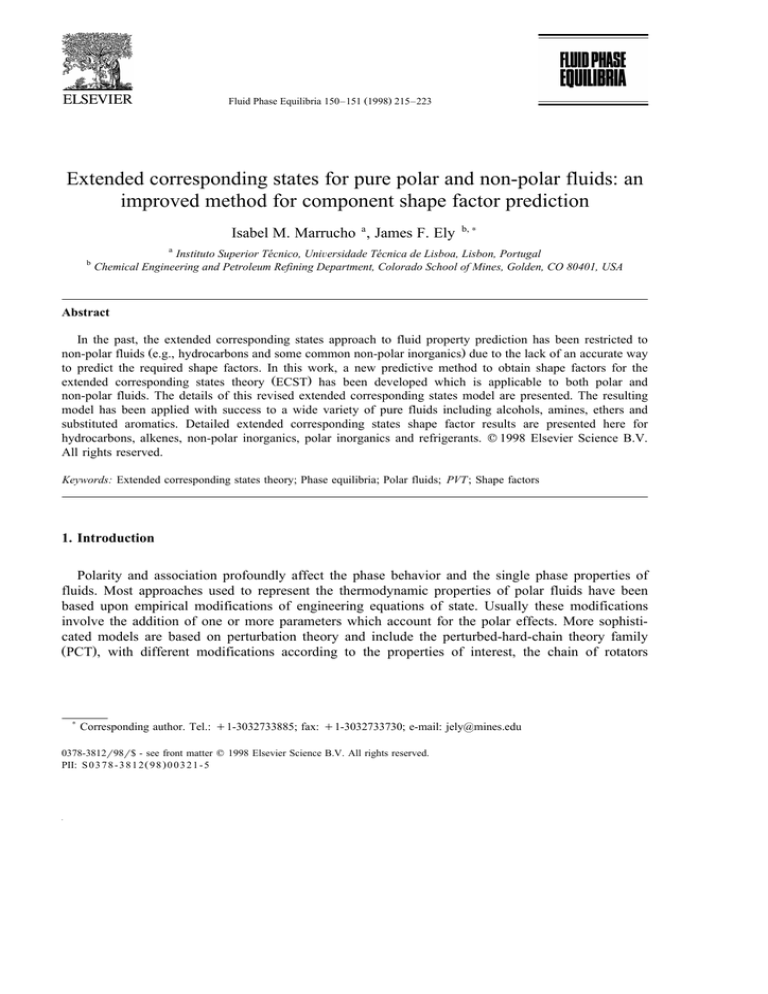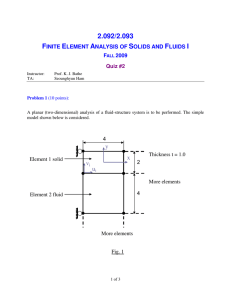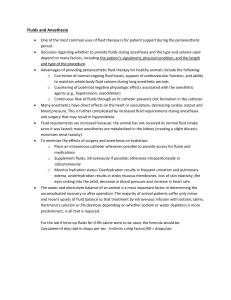
Fluid Phase Equilibria 150–151 Ž1998. 215–223
Extended corresponding states for pure polar and non-polar fluids: an
improved method for component shape factor prediction
Isabel M. Marrucho a , James F. Ely
b, )
a
b
Instituto Superior Tecnico,
UniÕersidade Tecnica
de Lisboa, Lisbon, Portugal
´
´
Chemical Engineering and Petroleum Refining Department, Colorado School of Mines, Golden, CO 80401, USA
Abstract
In the past, the extended corresponding states approach to fluid property prediction has been restricted to
non-polar fluids Že.g., hydrocarbons and some common non-polar inorganics. due to the lack of an accurate way
to predict the required shape factors. In this work, a new predictive method to obtain shape factors for the
extended corresponding states theory ŽECST. has been developed which is applicable to both polar and
non-polar fluids. The details of this revised extended corresponding states model are presented. The resulting
model has been applied with success to a wide variety of pure fluids including alcohols, amines, ethers and
substituted aromatics. Detailed extended corresponding states shape factor results are presented here for
hydrocarbons, alkenes, non-polar inorganics, polar inorganics and refrigerants. q 1998 Elsevier Science B.V.
All rights reserved.
Keywords: Extended corresponding states theory; Phase equilibria; Polar fluids; PVT; Shape factors
1. Introduction
Polarity and association profoundly affect the phase behavior and the single phase properties of
fluids. Most approaches used to represent the thermodynamic properties of polar fluids have been
based upon empirical modifications of engineering equations of state. Usually these modifications
involve the addition of one or more parameters which account for the polar effects. More sophisticated models are based on perturbation theory and include the perturbed-hard-chain theory family
ŽPCT., with different modifications according to the properties of interest, the chain of rotators
)
Corresponding author. Tel.: q1-3032733885; fax: q1-3032733730; e-mail: jely@mines.edu
0378-3812r98r$ - see front matter q 1998 Elsevier Science B.V. All rights reserved.
PII: S 0 3 7 8 - 3 8 1 2 Ž 9 8 . 0 0 3 2 1 - 5
216
I.M. Marrucho, J.F. Ely r Fluid Phase Equilibria 150–151 (1998) 215–223
ŽCOR., the Boublick–Alder–Chen–Kreglewski Ž BACK. equation of state and the statistical association fluid theory ŽSAFT.. A detailed review of these models as well as others is given in Ref. w1x.
One the of more accurate approaches to predicting properties of non-polar fluids, the extended
corresponding states theory Ž ECST. , has not found much success for polar fluids. This has been due
to the inaccurate prediction of the shape factors required in the ECST model and the simple mixing
rules typically used with this approach. The potential advantages of this model are the incorporation
of high accuracy reference fluid equations of state and the well-defined theoretical approximations
which underlay its application. The revised ECST model reported here presents a new way of
predicting andror correlating component shape factors. It has been applied with success to a wide
variety of pure fluids including alcohols, amines, ethers and substituted aromatics, both for single
phase and equilibrium properties.
2. Revised ECST shape factors for pure fluids
In the late 1970s and early 1980s, high accuracy equations of state based on wide-range
experimental data for homologous series became available, which made possible the exact Ž although
numerical. calculation of shape factors. Given these high accuracy equations of state, shape factors
can be found from the simultaneous solution of the equations,
a rj Ž Vj ,Tj . s a r0 Ž V0 ,T0 . s a0r Ž Vjrh j ,Tjrf j .
Ž1.
z jr Ž Vj ,Tj . s z 0r Ž V0 ,T0 . s z 0r Ž Vjrh j ,Tjrf j .
Ž2.
and
where the scaling factors f j and h j are defined below and a notation has been introduced in which a
dimensionless residual property is denoted by a lower case letter with a superscript ‘r’. For example,
in Eq. Ž1. above a r0 ' w A 0 Ž V0 ,T0 . y A 0 )Ž V0 ,T0 .xrRT where ‘)’ denotes an ideal gas value. The
mathematical details of the implementation of the ECST are given in the literature w2x.
For the great majority of fluids, the high accuracy equations of state required to solve Eqs. Ž 1. and
Ž2. are not available. Thus, the application the ECST for those fluids requires the prediction of the
shape factors. So far, the exact shape factors have been found to be temperature and density
dependent. However, it is possible to calculate shape factors which are density independent and are a
good representation of the exact ones in certain parts of the phase diagram.
2.1. Subcritical shape factors
A good example of density independent shape factors are those obtained from the mapping of the
saturation boundaries of the reference fluid ‘0’ and the target fluid ‘ j’ by simultaneous solution of the
following equations w3x:
Pjsat Ž Tj . s p 0sat Ž Tjrf j . h jrf j
Ž3.
r jsat ,l Ž Tj . s r 0sat ,l Ž Tjrf j . rh j
Ž4.
I.M. Marrucho, J.F. Ely r Fluid Phase Equilibria 150–151 (1998) 215–223
217
where P sat and r sat represent the saturated pressure and density, T denotes the temperature and f j
and h j are the equivalent substance reducing ratios, which are defined as functions of the shape
factors, u Ž V,T . and f Ž V,T .,
h j s Ž Vj crV0c . f Ž V ,T . and f j s Ž TjcrT0c . u Ž V ,T .
Ž5.
The exponent ‘c’ denotes the critical property. Analysis of the exact shape factors in the subcritical
region shows weak density dependence, thus allowing, to a very good approximation, the use of the
saturated shape factors in this region. As summarized in Ref. w4x, shape factors determined from Eqs.
Ž1. – Ž5. have been fitted to simple functions of reduced temperature such as
u s 1 q Ž v y v 0 . a1 q a2 ln Ž T ) .
Ž6.
and
Fs
Zc
ž /
Z0c
f s 1 y Ž v y v 0 . b 1 q b 2 ln Ž T ) .
Ž7.
and then used to make ECST predictions over the entire thermodynamic surface. In this work we have
developed improved functional forms to represent the shape factors and better methods to predict the
parameters used in those functional forms.
In order to calculate the shape factors along the saturation boundary, analytical expressions for the
saturated pressure and liquid density must be known. The simplest equation for correlation of the
vapor pressure with a sound physical basis is the Frost–Kalkwarf equation w5x, which in its reduced
form can be written as
ln p
) ,sat
sB)
ž
1
T)
/
y 1 q C )ln T ) q D)
ž
P ) ,sat
T )2
y1
/
Ž8.
where the superscript ‘)’ denotes a reduced value of the related quantities. D) is a universal
constant 27r64 and B ) and C ) depend upon the material under consideration. For the liquid
density, the Rackett equation gives a compact yet amazingly accurate means to estimate saturated
liquid volumes. In its original form it can be expressed as w6x:
V sat s V c Ž Z c . 1yT )
Ž
. 2r7
Ž9.
Using Eqs. Ž3. – Ž 5. and Ž8., the u shape factor can be written as
us
1 y C0 ) q ln F y D B ) q DC )ln Tj ) q Bj )rTj ) q D) Pjsat ,) Ž 1 y uF . rTj ) 2
1 y C0 ) q B0 )rTj )
Ž 10.
In deriving Eq. Ž10. , we have assumed that u is close to one and therefore ln u ( u y 1 and have
defined F s f Ž Z jcrZ0c , D B ) s Bj ) y B0 ) and DC ) s C j ) y C0 ). Analysis of exact shape factor
data along the saturation boundary shows that the term that multiplies D) is very small, contributing
I.M. Marrucho, J.F. Ely r Fluid Phase Equilibria 150–151 (1998) 215–223
218
at most 0.005 to the shape factor in a small region near the critical point. Away from the critical point
it typically contributes less than 0.00001. Thus, the term was neglected. Since there are two unknowns
remaining, u and F , another equation is needed. At saturation, h j is given by
hjs
Vj c
Vj sat Ž Tj ) .
V0
V0sat Ž Tj )ru .
fs
c
Ž 11.
If the Rackett equation w6x is used to calculate the saturated liquid volumes, the expression for f
becomes
Ž Z jc . 1yT )
Ž
fs
j
. 2r7
Ž Z0c . 1yT )ru
Ž
j
. 2r7
.
Ž 12.
As a first order approximation for f that is independent of u , we assume that u ( 1 and that, F f f .
The exponent of two is based on empirical observation and we note that more complicated
approximations are possible. The net result of these manipulations is our final expression for the u
shape factor
us
1 y C0 ) q 2 Ž 1 y Tj ) .
2r7
ln Ž Z jcrZ0c . y D B ) q DC )ln Tj ) q Bj )rTj )
1 y C0 ) q B0 )rTj )
Ž 13.
Note that as a consequence of our approximation concerning F , u approaches unity at the critical
point. It is also important to note a very important feature of the shape factor formulas given in Eqs.
Ž12. and Ž13.. In particular, this formulation is easily transferable between reference fluids since the
reference fluid parameters appear explicitly in the shape factors. This should be compared to the
formulation given in Eqs. Ž6. and Ž7. which is reference fluid specific and can only be used with other
reference fluids through cumbersome transformation formulas w4x.
Given this new formulation, it is possible to correlate the u and f shape factors by fitting B ) and
C ) in Eq. Ž13. and Z jc and the exponent ´ Žs 2r7 in the original Eq. Ž12.. in the Rackett equation to
saturation data. Fig. 1 illustrates the results that can be obtained from these equations for n-pentane as
compared to the exact values for the shape factors obtained from Eqs. Ž1. and Ž2.. The agreement,
even in the vicinity of the critical point, is excellent.
Since the goal of corresponding states theory is to predict fluid properties given a minimum of
information, typically the critical point parameters and acentric factor, a relationship between B ) and
C ) and the parameters available in a corresponding states calculation is required. By plotting
experimental data for non-polar and non-hydrogen bonding polar substances, Reynes and Thodos w7x,
found that C ) s 8r3 q 9B )r5 ln 10. Thus, it only remains to determine one parameter, B ), per
fluid. Using the observed relationship between B ) and C ) and Eq. Ž8. to calculate the acentric
factor, it is easy to show that B ) can be written in terms of v as
B ) s b 1 q b 2 v q b 310yv
Ž 14.
where for the relationship between B ) and C ) given above, b 1 s y6.207612, b 2 s y15.37641 and
b 3 s y0.574946. Thus, in the subcritical region, the relationships developed here can be used in
either a correlative or predictive mode, given the information available.
I.M. Marrucho, J.F. Ely r Fluid Phase Equilibria 150–151 (1998) 215–223
219
Fig. 1. Comparison of correlated subcritical n-pentane shape factors obtained with Eqs. Ž12. and Ž13. to exact values
calculated with Eqs. Ž1. and Ž2..
2.2. Supercritical shape factors
At supercritical conditions there is no accepted, accurate way to estimate the shape factors. Several
unique lines in this region have been analyzed in this study, including, the critical isochore and the
zeno Žunit compressibility factor. line w8x. Fig. 2 illustrates the exact shape factors found along these
lines and the saturation boundary for methane. In examining Fig. 2, we conclude that in the
single-phase region where the lines do not coincide, it is not possible to characterize the behavior of a
fluid without the introduction of density dependence in the shape factors. The observed density
dependence in the shape factors in this region can in part be due to uncertainties in the equations of
state Žaccording to the techniques used in their construction. and in the experimental data upon which
they depend. We contend, however, that this apparent density dependence is primarily due to the fact
that the two-parameter corresponding states principle requires that the critical compressibility factors
of the target and reference fluids be identical at the critical point—something that is not generally
observed in nature. Thus, we see a strong ‘hook’ in the subcritical shape factors at the critical point
and a near-critical region where two temperature dependent only paths give different values for u and
F.
From the two-parameter corresponding states relation for the pressure at the critical point of the
target fluid we find that
c
F s
Zc
ž /
Z0c
f c s p0 )
ž
1
u
c
,
1
f
c
/
uc
I.M. Marrucho, J.F. Ely r Fluid Phase Equilibria 150–151 (1998) 215–223
220
Fig. 2. Illustration of the lack of correspondence along the critical isochore and zeno line for methane. The dashed curves are
the shape factors on the zeno line while the solid lines show values along the critical isochore.
Our construction of u as given in Eq. Ž13. requires that u c be unity which places the reference fluid
on its critical isotherm, where for a fairly large region around the critical point P0 ) ( 1. Thus, the
limiting subcritical value of f is Z0crZ c and we have chosen to set f equal to this constant value in
the supercritical region. Note that there is large precedent for this approximation, since this is the
Table 1
Comparison of exact and correlated subcritical shape factors
Fluid type
Np
u Shape factor
Eq. Ž13.
Eq. Ž6.
AAD RMS BIAS
Ž%.
Ž%. Ž%.
AAD RMS BIAS AAD RMS BIAS
Ž%.
Ž%.
Ž%.
Ž%.
Ž%.
Ž%.
AAD RMS BIAS
Ž%.
Ž%.
Ž%.
0.08
0.07
0.12
0.21
0.09
0.10
0.15
0.11
0.41
0.94
0.43
0.36
Hydrocarbonsa
1258 0.08
Alkenesb
258 0.09
Non-polar inorganics c 442 0.07
Polar inorganicsd
398 0.09
Refrigerantse
1135 0.06
Overall
3491 0.07
a
f Shape factor
0.09
0.11
0.11
0.12
0.07
0.09
y0.05
y0.06
y0.04
y0.05
y0.03
y0.05
Eq. Ž12.
0.10
0.08
0.16
0.26
0.12
0.13
0.00
0.00
0.00
0.00
0.00
0.00
0.16
0.58
0.36
1.09
0.15
0.32
0.19
0.66
0.48
1.33
0.18
0.39
Eq. Ž7.
y0.04
0.22
0.08
y0.20
0.00
y0.01
0.21
0.16
0.52
1.16
0.55
0.46
0.00
0.00
0.00
0.02
0.01
0.00
Hydcrocarbons: methane, ethane, n-butane, i-butane, n-pentane, i-pentane, n-hexane, i-hexane, n-heptane, cyclohexane.
Alkenes: ethylene, propylene.
c
Non-polar Inorganics: oxygen, nitrogen, carbon dioxide, argon, neon.
d
Polar Inorganics: ammonia, water, hydrogen sulfide, carbon monoxide.
e
Refrigerants: R11, R12, R22, R32, R123, R124, R125, R134a, R143a, R152a.
b
I.M. Marrucho, J.F. Ely r Fluid Phase Equilibria 150–151 (1998) 215–223
221
result obtained from simple Ž two-parameter. engineering equations of state where the volume
parameter is temperature independent w9x and all fluids have the same critical compressibility factor.
As for u , we assume that the critical isochore of the target fluid is linear and map that isochore onto a
nearby Ž assumed linear. isochore of the reference fluid via the following relationship,
fs
Tjc
h 0 Ž pjc y Tjcg jc . q Ž h 0 g jc y g 0s . Tj
T0
p 0s y g 0s T0s
us
c
Ž 15.
where the superscript ‘s ’ indicates the isochore which intersects the reference fluid saturation
boundary at r 0s s r h 0 , h 0 s Z0c r 0crZ jc r jc and g ' Ž EPrET . r . g c for the target fluid may be obtained
from the Frost–Kalkwarf equation where Ž a s 1. as
g jc s a pjc Ž C j) y Bj) y 2 D ) . Ž 1 y D) . Tjc .
Ž 16.
Our studies have shown that with a s 1, Eq. Ž16. tends to underestimate the slope of the critical
isochore by about 2%. Thus we have empirically set a s 1.02.
3. Results
In Section 2, a new technique for correlating and predicting shape factors, which allows a more
accurate description of the phase diagram, especially in the subcritical region, was developed. This
new method has been applied to 325 pure fluids from several families already mentioned. In order to
compare with previous implementations of ECST, we are only reporting results for 31 fluids for
which we have high accuracy, wide range equations of state. Table 1 compares the results obtained by
correlating the subcritical shape factors with the new and old functional forms for typical fluids
investigated in this study. Table 2 presents comparable results obtained by using the two models in a
predictive mode where only the critical point and acentric factor are given as input. Table 3 presents
the results of predicting the supercritical shape factors along the critical isochore using the new and
old procedures. The improved performance of the new predictive methods, especially in the
subcritical region, is obvious. Also, this new method allows a more accurate correlation and
Table 2
Comparison of exact and predicted subcritical shape factors
Fluid type a
Np
u Shape factor
Eq. Ž13.
Eq. Ž6.
Eq. Ž12.
Eq. Ž7.
AAD RMS BIAS
Ž%.
Ž%. Ž%.
AAD RMS BIAS
Ž%.
Ž%. Ž%.
AAD RMS BIAS
Ž%.
Ž%. Ž%.
AAD RMS BIAS
Ž%.
Ž%. Ž%.
0.22
0.21
0.43
1.23
0.49
0.45
0.25
0.57
0.43
1.14
0.19
0.38
0.53
0.70
1.77
9.15
3.61
2.69
Hydrocarbons
1258 0.17
Alkenes
258 0.34
Non-polar inorganics 442 0.16
Polar inorganics
398 0.54
Refrigerants
1135 0.20
Overall
3491 0.23
a
f Shape factor
0.15
0.09
0.14
0.46
0.19
0.19
0.05
y0.31
y0.10
0.02
0.11
0.02
Fluid type groupings are defined in Table 1.
0.25
0.25
0.23
0.74
0.34
0.33
0.02
y0.01
0.36
y0.80
0.36
0.16
0.21
0.72
0.54
1.38
0.17
0.41
0.04
y0.06
0.07
y0.14
0.10
0.04
0.40
0.34
0.70
1.70
0.90
0.75
y0.11
y0.51
y1.73
7.77
2.93
1.54
I.M. Marrucho, J.F. Ely r Fluid Phase Equilibria 150–151 (1998) 215–223
222
Table 3
Comparison of exact and predicted supercritical shape factors
Fluid type a
Np
Hydrocarbons
510
Alkenes
102
Non-polar inorganics 255
Polar inorganics
204
Refrigerants
255
Overall
1326
a
u Shape factor
f Shape factor
Eq. Ž15.
Eq. Ž6.
f s Z0c rZ c
Eq. Ž7.
AAD RMS BIAS
Ž%.
Ž%. Ž%.
AAD RMS BIAS
Ž%.
Ž%. Ž%.
AAD RMS BIAS
Ž%.
Ž%. Ž%.
AAD RMS BIAS
Ž%.
Ž%. Ž%.
0.96
0.39
0.69
0.56
0.28
0.67
0.72
0.55
1.91
1.12
1.16
1.08
3.06
1.65
7.27
3.37
3.73
3.94
3.61
2.26
7.13
3.10
4.07
4.19
0.77
0.38
0.49
0.40
0.30
0.54
0.59
0.17
y0.41
0.40
0.11
0.24
0.62
0.59
1.24
0.75
0.87
0.81
0.32
y0.20
y1.69
y0.79
y0.42
y0.42
1.85
1.82
5.25
2.79
3.28
2.92
y2.69
y0.30
6.72
2.75
0.29
0.71
1.94
2.41
5.49
3.06
3.50
3.13
y2.95
1.13
6.36
2.01
y0.84
0.32
Fluid type groupings are defined in Table 1.
prediction of the shape factors in the near-critical region than was previously possible. Since the
accuracy of the calculated thermodynamic properties is a reflection of the accuracy of the shape
factors themselves, the description of the fluids through this new formulation will be significantly
improved compared to the previous ECST formulation.
4. Summary and conclusions
In this work we have developed new methods for correlating and predicting the component shape
factors for the extended corresponding states approach to fluid properties. Unlike previous methods,
these methods are transferable from one reference fluid to another, are not limited to non-polar
substances and, therefore, offer a means of making more accurate predictions for polar fluids. Future
work will include the incorporation of more sophisticated mixing rules in the revised extended
corresponding states model so that more accurate predictions may be made for polar–polar and
polar–non-polar mixtures.
Acknowledgements
I.M. Marrucho thanks JNICT, Programa Ciencia, BD _ 1534 _ 91-RM, for financial support of this
work through a fellowship. J.F.E. acknowledges the support of the U.S. Department of Energy, Office
of Basic Energy Science, grant No. DE-FG03-95ER41568.
References
w1x I.M. Marrucho-Ferreira, Extended Corresponding States Theory: Application for Polar Compounds and Their Mixtures,
PhD Thesis, University of Lisbon, 1997.
w2x J.F. Ely, Adv. Cryo. Eng. 35 Ž1990. 1520.
w3x A.S. Cullick, J.F. Ely, J. Chem. Eng. Data 27 Ž1982. 276.
I.M. Marrucho, J.F. Ely r Fluid Phase Equilibria 150–151 (1998) 215–223
223
w4x J.F. Ely, I.M.F. Marrucho, The corresponding states principle, in: J.V. Sengers ŽEd.., Equations of State for Fluids and
Fluid Mixtures, Blackwell, Oxford, 1997.
w5x A. Frost, D.R. Kalkwarf, J. Chem. Phys. 21 Ž3. Ž1953. 264.
w6x H.G. Rackett, J. Chem. Eng. Data 15 Ž1970. 514.
w7x E.G. Reynes, G. Thodos, Ind. Eng. Chem. Fundam. 1 Ž2. Ž1962. 127.
w8x J. Xu, D.R. Herschbach, J. Phys. Chem. 96 Ž1992. 2307.
w9x J. Mollerup, Fluid Phase Equilib. 4 Ž1980. 11.





